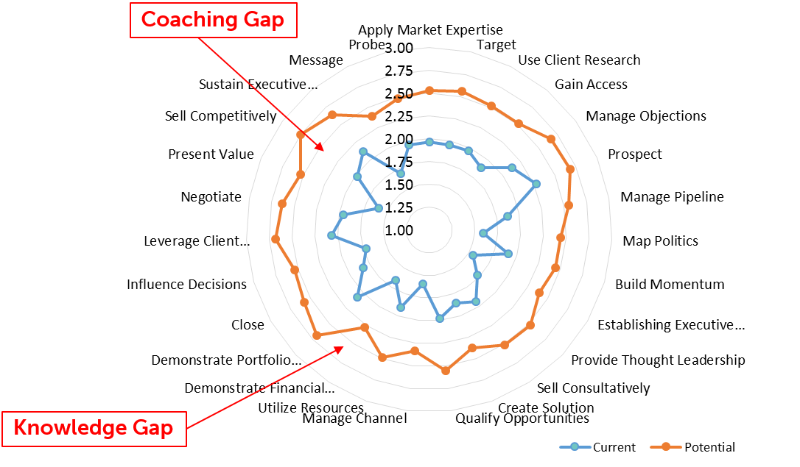
Why Your Sales Training Isn't Working
So sales are sluggish, the sales reps have been struggling to retire quota for the past three quarters, and if things don’t turn around there’s going to be a workforce reduction to try and slow the bleeding.
Let’s assume it’s not a manufacturing issue, a structural issue, a marketing issue – the bottom line is the reps just aren’t getting it done. The heat is turned up on the sellers by the sales leaders, outside consultants are called in, and training receives a flurry of requests to try and fix the problem. Stop me if you’ve heard this story before…
The first question might be how things were allowed to get this far out of kilter. It would be the wrong question to ask at this particular time when crisis containment is called for, but it’s asked anyway as people start looking to assign blame on anyone other than themselves. At some point during this inquisition training is reviewed; how many training hours were delivered and what were the courses. More training is ordered up, because obviously the reps had suddenly forgotten how to do their jobs. The irony is they’re right, training in fact is the issue, but what constitutes training is almost always misconstrued.

People have a phenomenal capacity to learn, and sellers learn not only from the formal training delivered by training groups, but also from socialized learning (person to person exchange of information) and from experiences on the job. Training encompasses all three of these areas of learning, not just the formalized learning coming from classrooms, books, or online courses. The amount of knowledge a person has about any given topic is typically far greater than what is indicated on a transcript, especially if the topic is one’s profession, such as selling. So, when things start heading south in the sales world, it’s less likely a function of the reps knowing what to do, and more likely a function of the reps not doing what they already know.
This is what’s known as the “knowing-doing gap”, and closing this gap requires a specialized form of training which emanates from socialized learning. It’s called coaching, and it’s the key difference between training existing as a “one and done” event with limited recall and application, versus reinforcing a given topic in a targeted, timely way in the field so as to compel a behavioral change which moves a business’ financial needles.
It’s just about impossible to find any data stating coaching is bad for sales, although there is a lot of evidence of poor coaching or lack of coaching being detrimental in many ways. While coaching can be executed by anyone properly trained in the skill – a member of the training team, perhaps – it is far more impactful and practical for coaching to be done by one’s leader. This highlights the need for leaders who are properly trained in coaching, and to ensure they’re actually doing it, which many (most?) aren’t. When it comes to sales coaching, most sales leaders feel they’re executing coaching regularly, but most sellers feel they’ve never been coached. Leaders might think they can just slip coaching into their normal daily lexicon, so they’re not surprised that a seller feels that they’ve never been coached, but they’d be wrong in thinking this. Coaching is an active, two-way, semi-scripted, enabling conversation leaving no doubt as to the goal of the coaching session and what the expectations are when the coaching session is completed. It is not a leader asking for a status report and directing a person to take a specific action, sometimes delivering that direction as an ultimatum. If a pipeline conversation is confrontational and threatening rather than enabling, then coaching hasn’t occurred – enabling being the operative word.
Fixing the knowing-doing gap isn’t done overnight, but it can be fixed, or at least the situation can be improved. There are several things that have to take place:
Invest in a solid, modern coaching program for your leaders
Coaching has changed. If your perception of coaching was formed back in the 80’s or 90’s, or if you’re coaching as you’ve been coached, then it’s time to take a fresh look at it. I’d suggest looking at the GROW model, such as InsideOut Development’s program. Either bring in a vendor to teach it or get certified and bring the program in-house. Either way, both the leaders and the training teams have to become SMEs in coaching for this to work.
Embed certified coaches from the training team into the sales teams
The goal is to create a behavioral shift in the leaders. Without having trainers working with sales leaders, most leaders will revert back to their wheelhouse and direct rather than coach, swoop in and fix a problem themselves rather than enabling their sellers fix the problem using the knowledge and skills they already have. Embedded trainers have to develop a working relationship with sales leadership to the point where they can listen in on various conversations and tap the leaders on the shoulder, guiding them in how they’re coaching.
Measure what the sellers know and are doing
This is a critical step. Without an objective measurement of where the sales force currently sits in its sales competency, it’s impossible to derive metrics and determine what has to be done and to measure the shift in behavior. You may have some success with training efforts based upon intuition and experience and see an improvement in lagging indicators such as revenue generation and margin, but you’ll never be able to pinpoint which behaviors are driving that change and target your training without some type of measurement device. Multiple assessment tools exist to baseline your salesforce selling competencies and behaviors. None are perfect, but it’s far better than “winging it” when you’re trying to determine what to train to. Shop around, pick one, and implement it across all your quota carriers and leaders.
Analyze the data to determine where and whether coaching or knowledge transfer (i.e. taking a formal training class) is needed
Depending upon which assessment tool you choose to use, various numbers of behaviors and competencies will be identified and measured at the individual and group levels.

Here’s an example of an individual’s score on an assessment that has been translated to a spider graph for easy visualization. The inner blue line represents where the person is currently performing, while the outer orange line shows the capability of the person. The knowing-doing gap lies between the two, and is addressed through training in the form of coaching by the leader, not making the individual sit through more training classes. Having the seller engage in formalized training will expand the outer orange circle, but such effort is largely wasted if the seller isn’t doing what they already know how to do. Once the inner blue circle begins to approach the outer orange circle, then greater benefit will be gained through formal training. Until that point, coaching is required to get the seller proficient with what knowledge they already have.
Focus the training (both coaching and formalized knowledge transfer) for the fastest and most efficient results
In the example above there are 27 different competencies with associated behaviors that can benefit from training. When it comes to behavioral change, people can focus on only a handful of behaviors at a time – realistically, just one or two. To determine on which few competencies training resources are best spent, approach it in the following manner:
Correlate the competency scores against the few key lagging indicators the C-suite is tracking.
Do a Pareto analysis to determine which competencies are driving 80% of the lagging indicator. These are your leading competency indicators on which to focus. There could be just one or two that are impactful, or there could be several.
Choose one or two leading competencies on which to focus, based upon resources and which the leaders wish to tackle, determine the behaviors associated with these competencies, and design training around them.
Execute the training (mostly coaching, with some formal knowledge transfer to support it when needed). Don’t expect changes to occur in a week; expect behavior modification to become rote in no less than six to eight weeks. We’re not programming machines, we’re programming people.
Repeat these steps every quarter or so to tackle the next set of competencies. This is a process of continuous improvement, and is therefore never completed. Think of this as a game of Whack-a-Mole. Continuous improvement = Whack-a-Mole.
A properly certified training group can support and greatly improve the coaching sessions between leaders and sellers, and it requires leadership to recognize training as being something more than a certain number of course hours being delivered. Training can improve leadership’s effectiveness, and it requires a level of partnership, trust, and willingness to learn, with which many sales leaders may have a difficult time. That being said, there are few, if any, other ways to close the knowing-doing gap and raise the performance of the sellers in a proactive, enabling manner.

By Bob Britton
Bob has been in sales and training for more than 20 years. He approaches corporate training through the lens of an MBA, understanding the dynamics of complex services, manufacturing, and sales environments, while simplifying it all so stakeholders across an organization communicate effectively. Bob leverages his military and corporate experience to build and lead teams which focus on cross-functional knowledge management, performance improvement, and paradigm alignment. Importantly, Bob understands how the field of training must adapt to the changes in marketplace, and how training must transform from a traditional information delivery function to a trusted business partner, which directly and measurably impacts behaviors to move the business needles.
Find out more about Bob Britton on LinkedIn







